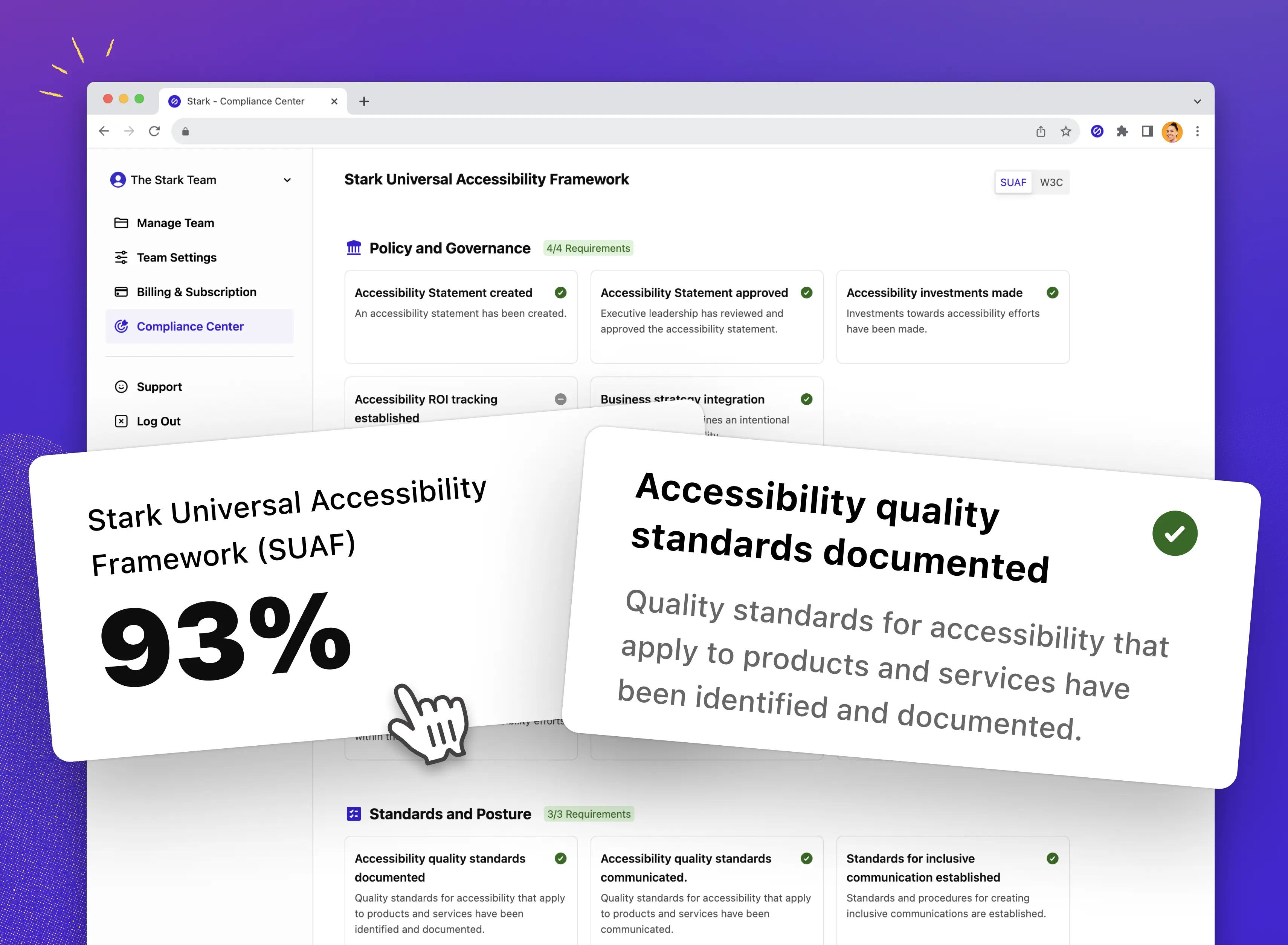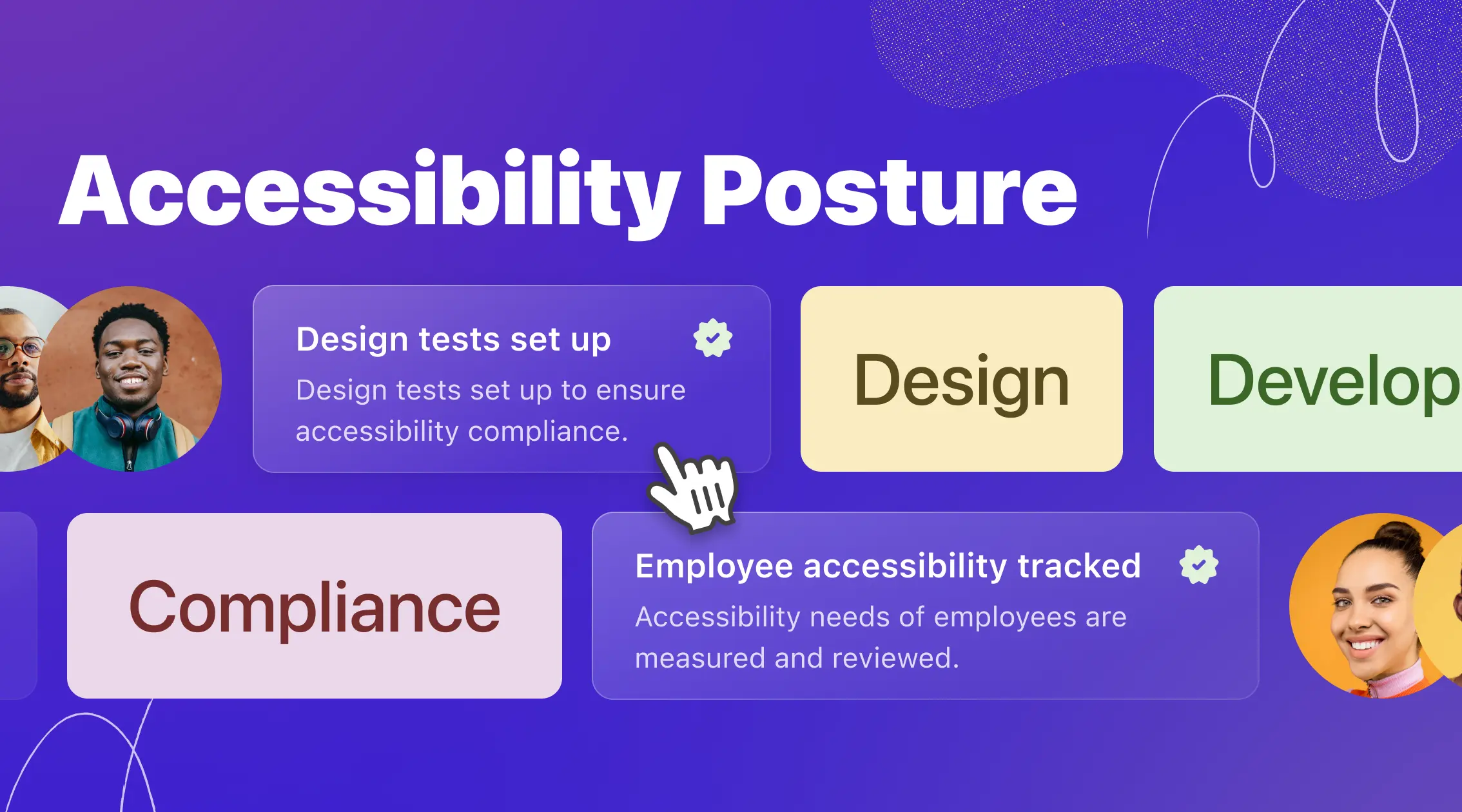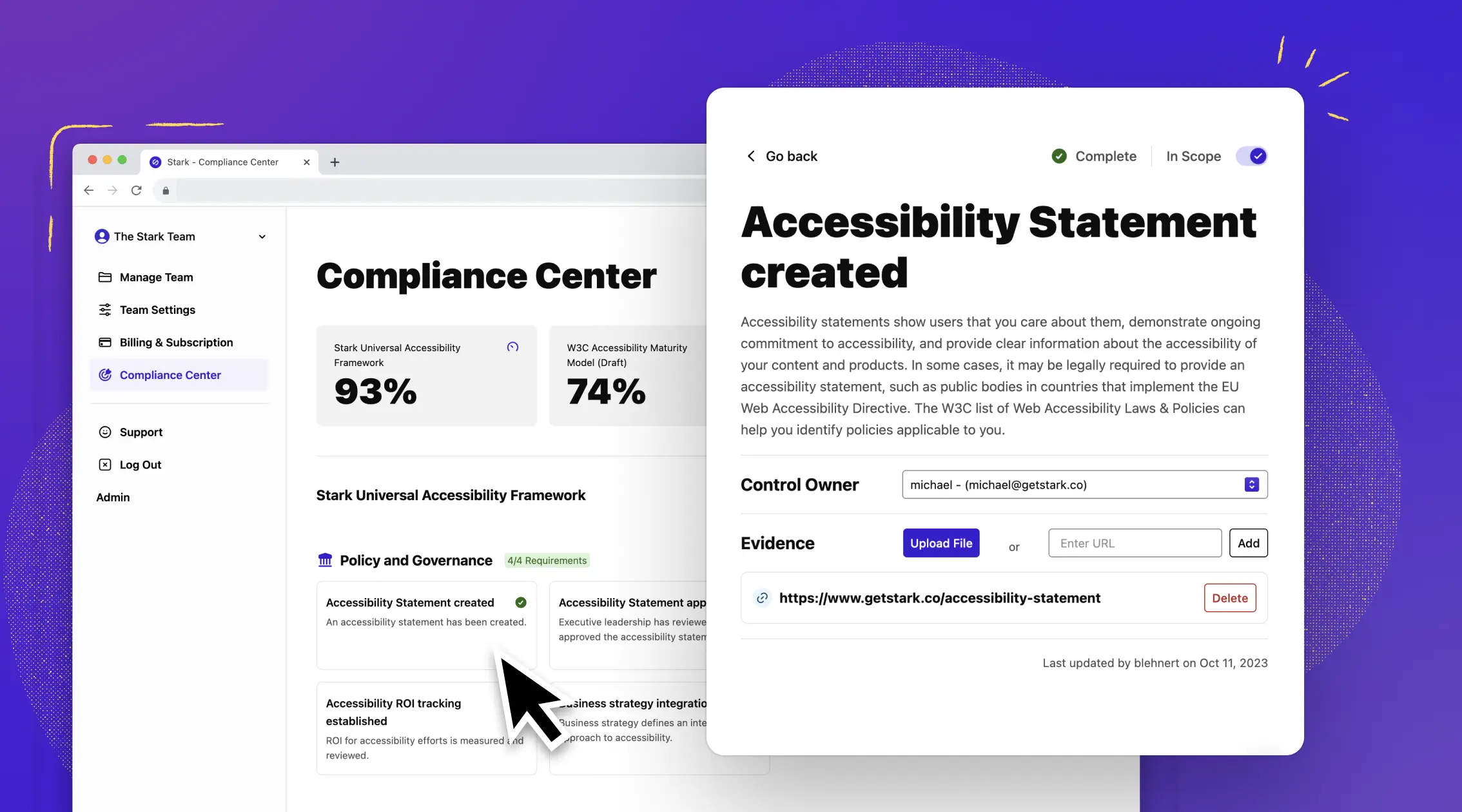How legal teams can navigate accessibility compliance with Stark
This guide describes in depth how legal teams can proactively monitor and manage a company’s digital accessibility posture in-line with the lastest regulatory requirements in Europe, Canada, and the U.S.

Team Stark
Aug 06, 2024

In the legal and compliance space, precision and foresight are essential to ensure sustainable business success. While legal teams have a wide spectrum of areas to cover, accessibility compliance is now fast following privacy and security when it comes to cases stacked on their virtual desks given the tightening regulations around the globe.
For a deep dive analysis of the current market trends, check out our industry white paper.
In software companies where product teams often get all of the love, Stark’s Accessibility Compliance Center offers a strategic solution for legal teams within enterprise organizations to ensure adherence to the complexities of accessibility regulations. With accessibility compliance being directly connected to contractual obligations toward customers, vendors, as well as employees, legal teams need to stay on top of it as part of their work – ideally without major operational overhead.
This comprehensive “control center” helps with maintaining current compliance and planning for legal landscapes coming down the pipeline fast, such as those shaped by the European Accessibility Act (EAA) and the Accessible Canada Act.
Stark’s Compliance Center is a transformative solution equipping you with the ability to navigate and manage digital accessibility compliance proactively, with precision and evidence-backed confidence by:
-
Staying ahead of regulatory curves
-
Monitoring accessibility compliance across departments in prep for audits
-
Assisting in budget planning to fill operational gaps
Stark’s Accessibility Compliance Center marks a pivotal move in proactively managing your company’s accessibility compliance posture. For legal teams, the Compliance Center is an educational resource as much as it is a compliance tool, keeping legal professionals at the forefront of regulatory requirements – just like you’re already used to from the privacy and security space.
Let’s dive into what that looks like in action…

Ahead of the global regulatory curve
Across the globe, a number of regulatory mandates and standards are coming down the pipeline of enforcement. And while we’re keeping you up-to-date, tracking these are notoriously difficult as you work to stay ahead of the curve.
The most comprehensive regulation being the European Accessibility Act (EAA) with an official deadline of June 28, 2025, at which point companies will have to comply. Similar legislation is going into effect in Canada. The United States, Australia and others are following quickly on the heels of these new, stricter regulations – just like we’ve seen with privacy and security laws being inspired by GDPR.
European Accessibility Act Insights
The European Accessibility Act (EAA) is a significant legislative initiative aimed at improving access to goods and services for people with disabilities across the European Union. This Act mandates that key products and services, including smartphones, computers, e-commerce platforms, and banking services, must be accessible in accordance with certain standards. The goal is to ensure persons with disabilities can access these services and products on an equal basis with others, fostering inclusivity and reducing barriers in the digital age.
The EAA impacts a wide range of businesses—particularly those in the technology, digital communications, and banking sectors, along with public services and e-commerce platforms. It requires them to make substantial adjustments to their products and services to meet accessibility standards. The enforcement deadline for the act is set for June 28, 2025, which is the date by which all member states must transpose the directive into national law and apply its provisions. Corporations should be aware of these requirements to ensure compliance, considering both the legal implications and the broader benefits of increased accessibility.
Accessible Canada Act
The Accessible Canada Act is designed to create a barrier-free Canada through the proactive identification, removal, and prevention of accessibility barriers. The Act primarily targets sectors under federal jurisdiction, including: banking, telecommunications, transportation services, and the federal government itself. It establishes a framework for developing and enforcing accessibility standards, intending to achieve a truly inclusive society where people with disabilities can fully participate.
Companies are required to recognize and address those barriers to accessibility, create detailed accessibility plans, and implement feedback tools to continuously improve accessibility standards. It also sets up the position of the Chief Accessibility Officer to oversee compliance and address systemic issues. Corporations must comply with these regulations as they are phased in, with various deadlines applying to different sectors.
Modernized U.S. regulation under the ADA
On April 8, 2024, the U.S. Department of Justice issued a final rule under the Title II of the Americans with Disabilities Act (ADA) to ensure digital services and content are accessible to people with disabilities, and set clear compliance deadlines for organizations based on their size. Overall, this new rule removes many of the previous ambiguities and creates clarity for both governmental organizations as well as their vendors and suppliers.
This clarity ensures state and local governments recognize the critical role digital platforms play in public life, making accessibility a fundamental right. This move aligns with current technological standards and best practices as well as international regulations in Europe, Canada and others, ensuring equitable digital inclusion.
Investing in continuous training, monitoring emerging technologies, and advocating for regular updates to accessibility standards are crucial for long-term success. State and local governments need clear policies defining their commitment to digital accessibility, with realistic deadlines and regular progress checks. This proactive approach ensures that digital platforms remain accessible, adapting to technological advancements and evolving user needs.
Real-time accessibility compliance monitoring with Stark
Just like we’re used to seeing from security compliance (e.g. SOC2, GDPR, etc.), Stark’s Compliance Center gives legal teams clarity through a set of different frameworks such as the Stark Universal Accessibility Framework (SUAF) and W3C’s Accessibility Maturity framework. These offer a comprehensive overview of what’s needed, which departments and leaders in the organization are responsible for which controls, and the various ones needed to achieve compliance.
Soon, the Compliance Center will also support specific geographical frameworks (e.g. to comply with the EAA or Section 508) and custom frameworks for companies that have their own internal guidelines and industry-specific regulations.
In prep for audits
Compliance Center offers a curated set of 31 controls spanning 8 dimensions as part of the industry-leading Stark Universal Accessibility Framework (SUAF), specifically designed to focus on the requirements and guidelines necessary for establishing a proactive accessibility posture.
This structured framework ensures that legal teams are not just reacting to compliance issues, but are anticipating and addressing them ahead of time. Organizations require both a clearly articulated framework, and tangible, measurable steps for execution across all parts of a company. Compliance Center helps companies start from the top and work their way down. Controls are always up-to-date and can assist in all operational processes from quarterly business reviews (QBR) and audits to sales and budget planning.
With our evidence-based monitoring, legal teams get to capitalize on a repository of compliance data that provides tangible proof of the company’s accessibility posture.

Finding all of the controls the legal teams are responsible for is easy! Once you do, go in and start tackling them as a team.
-
Click on a control.
-
Determine who the responsible person is for that control.
-
Source or create the documents needed for proof.
While currently focused on self-reporting, keeping every control updated helps demonstrate adherence to the highest standards and automatically tracks timestamps and metadata in the event of an audit. This level of documentation is crucial not only for internal audits, but also for any legal proceedings or compliance verifications that may arise.
Interdepartmental collaboration
For the first time in the space of digital accessibility, interdepartmental accountability has a spotlight on it. The Compliance Center promotes a collaborative environment by enabling monitoring alongside the product team. This shared visibility ensures that compliance is a collective responsibility. Each update and feature release will reflect the company’s commitment to accessibility.
While legal teams don’t often work directly with the product teams, accessibility is an area where interdepartmental collaboration is business critical. Accessibility primes the pump for working in tandem with product teams to ensure that the company’s digital offerings are not just compliant, but exemplary – given meeting compliance standards is merely the floor when it comes to building inclusive products.
Some starter questions to ask your product peers:
-
Do we have a method to determine how accessible we are, and if so how are we tracking toward compliance?
-
What are the services or tools needed to achieve that?
-
What timeframe can we realistically achieve that in?
-
Where do most of our accessibility issues originate?
-
How is accessibility tracked as part of our quality assurance process?
-
How long does it take to fix accessibility issues once they’re discovered?
-
How do we currently test with disabled people, and what do you need from legal to ensure we can?
-
What budget is needed to achieve compliance and in what time frame?
Embracing the Accessibility Compliance Center as part of the Stark platform is more than a legal safeguard—it’s a strategic advantage across all departments of the company. It signals to stakeholders, clients, and the market at large that your company is not only aware of its legal obligations but is actively pursuing becoming a leader in the realm of digital accessibility.
It’s crucial for legal teams to guide their companies in understanding these obligations to both meet legal requirements and contribute positively to societal inclusivity. Stark’s Compliance Center represents a keystone in the architecture of corporate compliance. It provides a clear path avoiding the pitfalls of non-compliance while also fostering an ethos of inclusivity and ethical practice.
With Stark, legal compliance in accessibility is transformed from a mandate to be met to a mission to be championed, so that accessibility compliance serves its true purpose: a world where software is accessible for everyone.
Get started with Compliance Center today
Compliance Center is included in all Stark Enterprise plans, and available as an add-on for Business plans. Book a demo today to experience Stark’s proactive accessibility compliance workflow.
And if you have any questions or feedback, don’t hesitate to reach out to us at support@getstark.co, or join the conversations in our Stark Slack Community, on LinkedIn, or on Twitter.